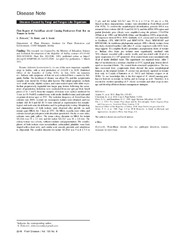Приказ основних података о документу
First report of Penicillium olsonii causing postharvest fruit rot on tomato in Serbia
| dc.creator | Zivkovic, Svetlana | |
| dc.creator | Ristić, Danijela | |
| dc.creator | Stošić, Stefan | |
| dc.date.accessioned | 2023-07-12T09:20:46Z | |
| dc.date.available | 2023-07-12T09:20:46Z | |
| dc.date.issued | 2021 | |
| dc.identifier.issn | 0191-2917 | |
| dc.identifier.issn | 1943-7692 | |
| dc.identifier.uri | https://plantarum.izbis.bg.ac.rs/handle/123456789/651 | |
| dc.description.abstract | Tomato (Solanum lycopersicum L.) is one of the most important vegetable crops in Serbia, with a total production of 111,639 t in 2019 (Statistical Office of the Republic of Serbia 2020). In July 2020, six tomatoes (cv. Balkan) with symptoms of fruit rot were collected from a market in Belgrade, Serbia. The incidence of disease was about 2%, and the symptomatic samples were stored for 10 days after harvest. The initial symptoms on fruits were small circular, slightly sunken, and water-soaked spots with white mycelia that progressively expanded into larger gray lesions following the occurrence of sporulation. Isolations were conducted from one spot per fruit. Small pieces (2 to 3 mm2) from the margins of lesions were surface sterilized for 1 min in 1% NaOCl, washed twice with sterile distilled water, and cultivated on potato dextrose agar at 25°C. The isolation frequency of Penicillium-like colonies was 100%. In total, six monosporic isolates were obtained, and two isolates (SZ-20-6 and SZ-20-7) were selected as representative for morphological and molecular identification and for pathogenicity testing. Morphological characteristics of both isolates were observed after growth on malt extract agar (MEA) for 7 days at 25°C. On MEA, mycelia were white, and colonies turned greyish-green with abundant sporulation. On the reverse sides, colonies were pale yellow. The mean colony diameter on MEA for isolate SZ-20-6 was 25 ± 1.2 mm and for isolate SZ-20-7 was 26 ± 1.0 mm. The colony texture was velvety, without exudates and pigmentation. The conidiophores of both isolates were terverticillate, unbranched; phialides were flask shaped with a short neck, and conidia were smooth, greenish, and subglobose to ellipsoidal. The conidial diameter for isolate SZ-20-6 was 3 to 4 × 2.5 to 3 µm, and for isolate SZ-20-7 was 3.5 to 4 × 2.5 to 3.5 µm (n = 50). Based on these characteristics, isolates were identified as Penicillium olsonii (Pitt 1979). To confirm the morphological identification, genomic DNA was extracted from isolates (SZ-20-6 and SZ-20-7), and the rDNA ITS region and partial β-tubulin gene (BenA) were amplified using the primers ITS1/ITS4 (White et al. 1990) and Bt2a/Bt2b (Glass and Donaldson 1995), respectively. All sequences showed 99 to 100% similarity to P. olsonii and were deposited in GenBank (ITS, MW130235 and MW130236; BenA, MW145147 and MW145148). In multilocus phylogenetic analysis (ITS + BenA), isolates from this study clustered together with other P. olsonii sequences with 100% bootstrap support. To complete Koch’s postulates, asymptomatic fruits of tomato cv. Balkan (five fruits per isolate) were superficially sterilized with 70% ethanol, wounded with a sterile needle, and inoculated with 10 µl of a spore suspension (1 × 106 spores/ml). Five control fruits were inoculated with 10 µl of sterile distilled water. The experiment was repeated twice. After 7 days of incubation in a moisture chamber at 25°C, typical gray lesions developed on inoculated fruits. The control fruits remained symptomless. The isolates recovered from symptomatic fruits showed the same morphological features as the original isolates. P. olsonii was previously reported on tomato fruit only in Canada (Chatterton et al. 2012) and Pakistan (Anjum et al. 2018). To our knowledge, this is the first report of P. olsonii causing postharvest fruit rot on tomato in Serbia, and in Europe as well. Therefore, it is essential to monitor spreading of P. olsonii on tomato and other crops in storage and develop efficient disease management strategies. | sr |
| dc.language.iso | en | sr |
| dc.publisher | American Phytopathological Society | sr |
| dc.relation | info:eu-repo/grantAgreement/MESTD/inst-2020/200010/RS// | sr |
| dc.rights | openAccess | sr |
| dc.rights.uri | https://creativecommons.org/licenses/by-nc-nd/4.0/ | |
| dc.source | Plant Disease | sr |
| dc.subject | Penicillium olsonii | sr |
| dc.subject | pathogen detection | sr |
| dc.subject | tomato | sr |
| dc.subject | Solanum lycopersicum | sr |
| dc.subject | fruit rot | sr |
| dc.title | First report of Penicillium olsonii causing postharvest fruit rot on tomato in Serbia | sr |
| dc.type | Информативни прилог | sr |
| dc.rights.license | BY-NC-ND | sr |
| dc.citation.epage | 2246 | |
| dc.citation.issue | 8 | |
| dc.citation.rank | M21 | |
| dc.citation.spage | 2246 | |
| dc.citation.volume | 105 | |
| dc.type.version | publishedVersion | sr |
| dc.identifier.doi | 10.1094/PDIS-02-21-0323-PDN | |
| dc.identifier.fulltext | http://plantarum.izbis.bg.ac.rs/bitstream/id/2703/bitstream_2703.pdf | |
| dc.identifier.scopus | 2-s2.0-85116113403 | |
| dc.identifier.wos | 000726783500035 |


